By Leigh Jerrard
Guest Writer – Greywater Corps
You’re probably irrigating your yard with drinking water, since the same water that comes out of your kitchen faucet also feeds your hose bibs. But do your plants need drinking water? It turns out that most plants are perfectly happy with gently used water from showers, bathtubs, laundry and sinks: greywater. This works out well, because the average American household uses about half its water indoors and the other half outside for irrigation. Some households can cut their water bills almost in half by irrigating with greywater.
Now that large swaths of the country are facing historic drought conditions, due to climate change, and we’re seeing all three of our water sources constantly in the news, Mono Lake, Colorado River and the Delta, this is the new normal. It especially doesn’t make sense to send perfectly good water down the drain.
Here are the benefits of greywater:
- You can recapture that water and use it again.
- It reduces a home’s carbon footprint, since moving and treating water consumes a tremendous amount of energy
- It protects the aquatic ecosystems from whence our water came
- It reduces stress on sewage systems and puts water back into the local aquifer, which is better than dumping it into rivers, lakes and oceans.
- If you’re on a septic tank, it reduces loads on the system, prolonging your service intervals
- It helps grow a beautiful and bountiful garden whether edibles, natives or tree canopies
Greywater systems don’t look like normal irrigation. For one thing, there’s stuff in it — small amounts of soap, hair, laundry lint etc. You can process the water and try to filter everything out, however, the better option is to send it directly to the landscape and use natural processes to break down impurities. No filter and no storage means little maintenance.
Setting up a greywater system involves:
- Plumbing: disconnecting fixtures from sewer and routing them to the greywater system, or plumbing new construction with separate greywater and blackwater drains.
- Installing the greywater system itself
- Installing irrigation in the yard
Elements common to all greywater systems
Diverter valve
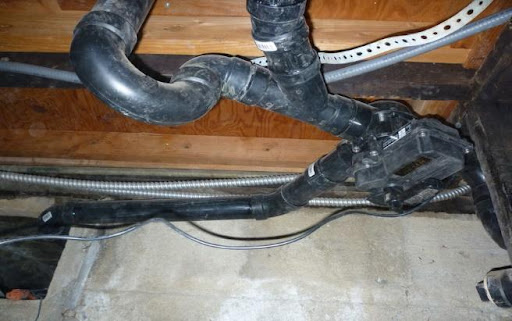
Diverter Valve
All greywater systems should have the ability to be turned off: if your plants are getting too much water or you’re putting something down the drain (like laundry bleach) that could harm your soil. The diverter valve allows you to send greywater back to the sewer if needed.
Woodchip Mulch
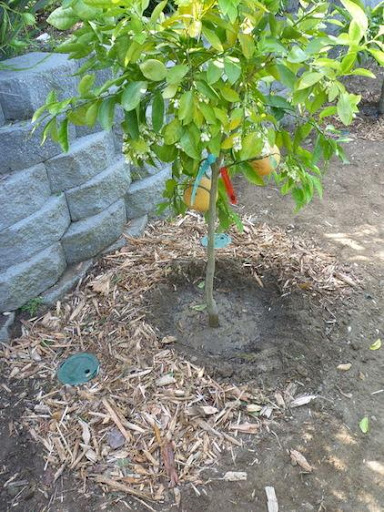
Woodchip Mulch
Woodchip Mulch Trenches in the ground full of woodchip mulch that filter greywater, allow it to percolate out through capillary action, and foster beneficial microbes that break down impurities.
Subsurface Emitters
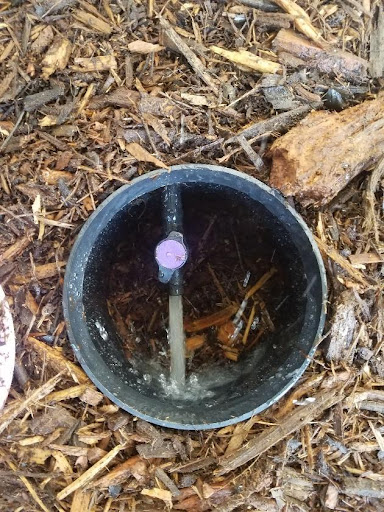
Subsurface emitters
Greywater is non-potable and cannot be sprayed or used in a “normal” irrigation system. All greywater emitters should be underground.
Basic Greywater Systems
Laundry-to-Landscape System
The easiest place to start with greywater is the washing machine. Since the water comes out of a hose on the back of the machine, there is no need to alter the plumbing under the house. The most common washing machine system is called a laundry-to-landscape system, which uses the washer’s internal discharge pump to help move water out into the yard, where it is distributed into mulch basins through a network of ½-inch ball valves.
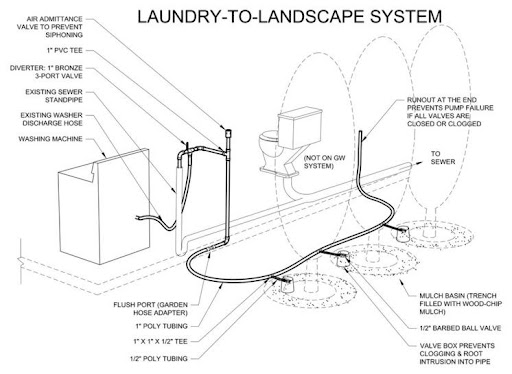
Diagram of a laundry-to-landscape system
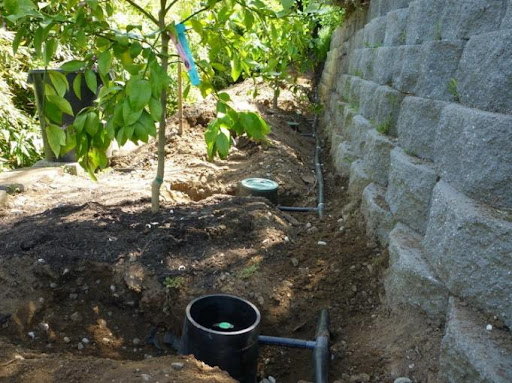
System during installation
Branched Drain System
This is a gravity-flow system with no storage tanks, pumps or filters; it relies on gravity and mulch to distribute water in the landscape. Drains from greywater fixtures are combined into a single pipe, which is piped out of the house. Once outside, the flow is divided and subdivided into multiple branches to be spread to various outlets in the yard. Since the pipes need to flow slightly downhill, this system may not work on large flat lots or if the area to be irrigated is above the house.
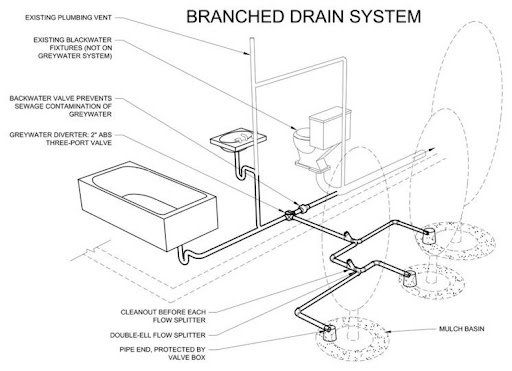
Diagram of a branched drain system
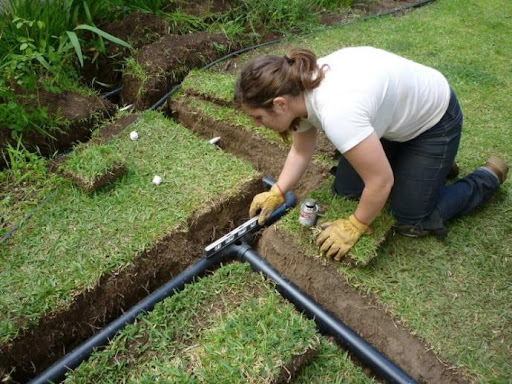
Leveling the flow splitter of a branched drain system
Pump-to-Mulch Basin System
If the areas to be irrigated are far from your house or uphill, you’ll need a pump. The best way to do this is with a pump-to-mulch basins system: Greywater drains to a basin containing a submersible pump that shoots the water out to mulch basins in the landscape. This system can irrigate an entire property
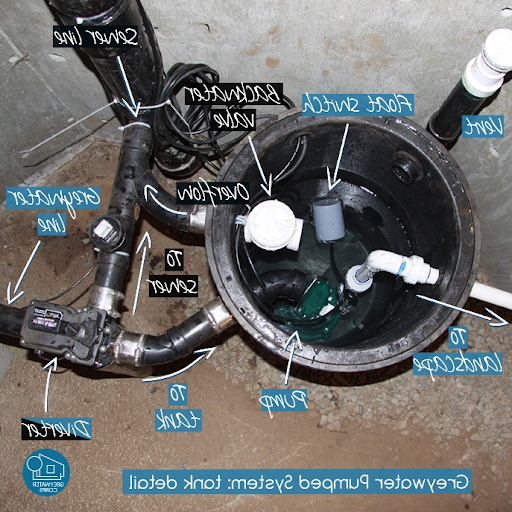
Pump-to-mulch basin system
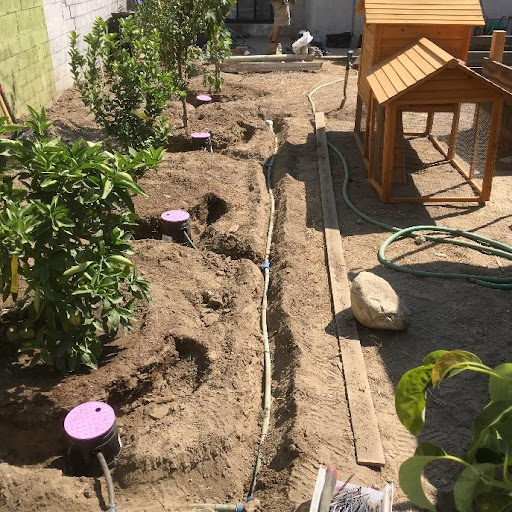
Pump-to-mulch basin system
Common Greywater Mistakes
Trying to water a lawn with it.
Greywater is non-potable and cannot be used in sprinkler systems. This makes almost all greywater systems incompatible with grass. Lawns in general use a tremendous amount of water; for folks considering greywater, we recommend tearing up the lawn and replacing it with native plants that don’t need external irrigation — then use greywater for fruit trees, shade trees, and larger ornamentals
Storing it.
Greywater should not be stored in a tank. Trace amounts of organic matter will cause anaerobic bacteria growth and funky odors. It’s better to just put it in your soil immediately.
Overcomplicating things.
Pumps and filters generally just mean more things that can break and that need maintenance. Don’t pump greywater if you can do the same job using gravity. Don’t install a filter system that involves routine cleaning unless you are willing to clean or replace it for the next 20 years.
Questions to Ask
Do you have pipe access below the bathrooms?
Second-story bathrooms can mean invasive replumbing to run separate greywater lines, and bathrooms directly on a slab-on-grade foundation can be impossible since the plumbing is entombed under concrete. However, you can almost always do a washing machine system, for which the greywater can be captured directly off the discharge pipe.
Are you planning to do the work yourself?
Laundry-to-landscape systems can be installed by a reasonably handy homeowner (although it helps to do plenty of research and attend a workshop first). Anything else will involve altering the building’s waste plumbing and should be undertaken only by a professional. Greywater Action is a great source of information and workshops are available.
Does your plumber have a basic understanding of greywater?
Many don’t. Greywater systems violate the essential plumber’s creed: that there is supply, and there is waste, and never the two shall meet. With greywater you are reusing “waste” as supply for irrigation (in other words, you aren’t wasting it!), which for some plumbers can cause the needle to scratch across the record and the saloon to go silent. Some of the weirdest greywater systems we’ve seen have been installed by plumbers.
Are there experienced greywater system installers in your area?
The bigger cities out West may have experienced greywater installers, but in most other areas you’ll be on your own. Recent interest in permaculture — integrated sustainable and self-sufficient agricultural ecosystems — has spawned interest in greywater, so that community may be a place to look for installers.
What are the local building codes?
Find out what’s legal and what needs a permit. After many years of restrictive greywater codes, many Western states have recently eased up on greywater. In California washing machine systems can be installed without permits if simple guidelines are followed.
See Leigh’s Greywater Presentation at: https://socalwatersierraclub.org/greywater-presentation-by-leigh-jerrard/
Leigh is the Founder of Greywater Corps, and a licensed architect and plumber.
Learn more at http://greywatercorps.com
